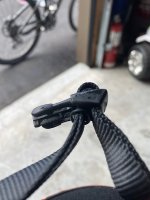Also - at my cottage we've been having some leaks during rains. My usual guy has been up there several times, each time claiming he had fixed it, but taking literal months to look at things each time water came through.
So I decided to pull the plug on that guy. I'm very loyal to my guys, and he has been very good to us over the years and I consider him my friend, but I hit my limit. Had a new roofer come in who suspected a spot - the shingle was lifting up there, it as on a flattish spot near a transition in the pitch, there was a rusty nail visible and it was pretty much above where the leak was. So he suggested I go up there later with a hose, apply water to the spot, and see if it leaked.
It didn't. There was some debris on the roof a few feet away from this spot, so while I was up there I decided to sweep. I found a clean hole about the size of a toonie underneath, almost certainly from a broken tree branch. Confirmed with the same hose that water applied to it will come back out inside. So that's a win, knowing where the water is coming in from.
Tried to cover it up with duct tape as it looked like it might rain. In case anyone is interested - duct tape does not adhere to wet shingles. Put some down anyways and sat a bottle of vinegar (LOL) on it to hopefully weight it down. Don't know why I didn't think of using a brick, but by the time I had that idea it was dark. Wife doesn't like the idea of me on the roof.
Come to think of it, I'm very surprised I don't hear about trephinations by falling tree branches. I find tree branches all over my property stuck vertically in the ground and have had similar holes punched in a bunch of other stuff (lawn furniture, SUPs, etc).
So I decided to pull the plug on that guy. I'm very loyal to my guys, and he has been very good to us over the years and I consider him my friend, but I hit my limit. Had a new roofer come in who suspected a spot - the shingle was lifting up there, it as on a flattish spot near a transition in the pitch, there was a rusty nail visible and it was pretty much above where the leak was. So he suggested I go up there later with a hose, apply water to the spot, and see if it leaked.
It didn't. There was some debris on the roof a few feet away from this spot, so while I was up there I decided to sweep. I found a clean hole about the size of a toonie underneath, almost certainly from a broken tree branch. Confirmed with the same hose that water applied to it will come back out inside. So that's a win, knowing where the water is coming in from.
Tried to cover it up with duct tape as it looked like it might rain. In case anyone is interested - duct tape does not adhere to wet shingles. Put some down anyways and sat a bottle of vinegar (LOL) on it to hopefully weight it down. Don't know why I didn't think of using a brick, but by the time I had that idea it was dark. Wife doesn't like the idea of me on the roof.
Come to think of it, I'm very surprised I don't hear about trephinations by falling tree branches. I find tree branches all over my property stuck vertically in the ground and have had similar holes punched in a bunch of other stuff (lawn furniture, SUPs, etc).





















